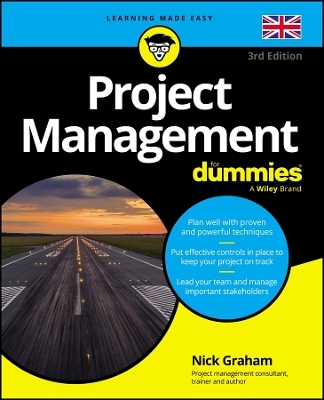
Project Management For Dummies - UK
For Dummies (Verlag)
978-1-394-20188-4 (ISBN)
Nick Graham is an experienced project practitioner, trainer and author, with his clear explanations helped by also being a qualified teacher. His training work has taken him worldwide, and he has worked with the public, private and not-for-profit sectors. Nick is also the author of Project Management Checklists For Dummies.
Introduction 1
About This Book 2
Foolish Assumptions 2
Icons Used in This Book 3
Beyond the Book 4
Where to Go from Here 4
Part 1: Understanding Projects and What You Want to Achieve 5
Chapter 1: Success in Project Management 7
Taking on a Project 7
Avoiding the Pitfalls 8
Deciding Whether the Job is a Project 10
Understanding the four control areas 10
Recognising the diversity of projects 12
Understanding the four stages of a project 13
Defining the Project Manager’s Role 15
Looking at the Project Manager’s tasks 16
Opposing opposition 17
Avoiding ‘shortcuts’ 18
Deciding On Your Approach 19
Chapter 2: Thinking Through the Life of Your Project 21
Using a Set Approach 21
Breaking the Project Down into Stages 22
Appreciating the advantages of stages 23
Deciding on the number of delivery stages 24
Understanding the Four Main Stages 25
Starting the project 25
The planning stage – organising and preparing 28
The delivery stages – carrying out the work 32
The closure stage 36
Chapter 3: Defining the Scope and Producing a Business Case 37
Defining the Scope 38
Managing expectations and avoiding disappointment 39
Challenging the scope 39
Understanding the dimensions of scope 40
Being clear 40
Considering the requirements 41
Producing a Business Case 41
Getting to grips with the basic contents 42
Keeping the Business Case up to date 42
Figuring out why you’re doing the project 43
Understanding project justification 44
Understanding benefits 45
Writing the Business Case 49
Complying with organisational standards 50
Going Back to the Scope 50
Challenging the existing scope 51
Going the second mile 51
Getting to Grips with Techniques 52
Calculating return on investment 52
Understanding cost–benefit analysis 52
Chapter 4: Knowing Your Project’s Stakeholders 55
Managing Stakeholders 56
Identifying stakeholders – the ‘who’ 57
Analysing the stakeholders – the ‘where’ 60
Understanding positions – the ‘why’ 62
Deciding action – the ‘what’ 63
Working with stakeholders – the ‘how’ 65
Planning the work – the ‘when’ 66
Handling Opposition 67
Solving the problems 67
Focusing on the common areas 67
Understanding that you’re a threat 67
Spotting facts and emotions 69
Overriding the opposition 70
Handling Multiple-Stakeholder Projects 71
Getting multiple approvals 71
Developing management strategies 71
Part 2: Planning Time: Determining What, When and How Much 73
Chapter 5: Planning with Deliverables First 75
Seeing the Logic of Product Planning 76
Thinking ‘product’ before thinking ‘task’ 76
Understanding the problems of an activity focus 78
Knowing What a Product Is – and Isn’t 79
Finding Good Product Names 80
Using a Business Project Example 81
Identifying the products 81
Developing a sequence 82
Defining the products 87
Using a Structured Product List 88
Unleashing the Power of the Work Flow Diagram 91
Using the Work Flow Diagram for risk 92
Using the Work Flow Diagram for control 92
Using the Work Flow Diagram to show stages 93
Using the Work Flow for progress reporting 93
Getting a picture of the project 95
Chapter 6: Planning the Activities 97
Moving From Products to Activities 98
Having multiple tasks to build a product 98
Listing the activities or tasks 99
Drawing Up a First Activity Network 101
Seeing how you build up an Activity Network 101
Using the Work Flow Diagram 103
Putting in the time durations 105
Calculating the length of the project 107
Understanding Float and Its Impact 109
Identifying the Critical Path 111
Watching the critical path 112
Finding a split critical path 113
Being More Precise with Dependencies 114
Understanding dependency types 114
Staying in touch with reality 117
Thinking a bit more about sequences 118
Working with the Activity Network 120
Working back to meet end dates 121
Avoiding backing into your schedule 122
Going for Gantt 123
Estimating Activity Durations 125
Getting the best information 126
Using estimating techniques 127
Putting a health warning on estimates 128
Chapter 7: Looking At Staff Resources 131
Seeing Why You Need to Plan Staff Use 132
Dealing with resource conflicts 132
Making sure that people are available 133
Monitoring use of staff on the project 135
Matching People to Tasks 135
Working out the skill sets and knowledge that you need on the teams 135
Growing your people 136
Identifying skills sets 137
Honing Your Task Duration Estimates 138
Documenting your estimates 138
Factors in activity timing and estimates 139
Estimating required work effort 140
Factoring in productivity 141
Taking care with historical data 144
Accounting for availability 145
Smoothing the Resource 146
Checking for resource conflict 146
Resolving resource conflicts – the steps 147
Co-ordinating assignments across multiple projects 149
Chapter 8: Planning for Other Resources and Developing the Budget 151
Determining Physical Resource Needs 152
Identifying resource needs 152
Understanding physical resources 154
Thinking a bit more about timing 155
Preparing a Budget 156
Looking at different types of project costs 157
Developing a project budget at three levels 159
Creating a detailed budget estimate 160
Refining your budget through the stages 162
Avoiding drowning people in detail 164
Chapter 9: Planning at Different Times and Levels 165
Putting the Main Structure in Place 166
Deciding on the stages 166
Holding a Stage Gate 168
Working with Planning Levels 169
Drawing up new plans 170
Keeping higher level plans up to date 172
Planning at more than one level at once 172
Chapter 10: Dealing with Risk and Uncertainty 175
Understanding Risks and Risk Management 176
Seeing why you need risk management 177
Managing, not necessarily avoiding, risk 177
Keeping people informed 178
Keeping risk in focus throughout the project 180
Working Through the Risk Cycle 180
Identifying a risk and its trigger event(s) 182
(Re)analyse the risk and check existing actions 183
Deciding risk management action(s) 189
Add/modify risk management in the plans 193
Take planned action(s) and monitor the risk 194
Documenting Risk 195
Risk Plan 195
Risk Log 196
Getting Some Help from Techniques 197
Ishikawa (fishbone) diagram 197
Work Flow Diagram 198
Risk Checklist 198
Decision tree 198
Chapter 11: Controlling Quality 201
Understanding the Effects of Getting Quality Wrong 203
Understanding the impact of poor quality 203
Avoiding the cost of unnecessarily high quality 204
Defining Quality 205
Striking the Quality Balance 205
Balancing quality against project effort (and more) 205
Thinking through what quality level you need 206
Identifying when quality levels are mandatory 208
Spotting Quality Game-Playing and Working to Prevent It 208
The quality level game and a guilty conscience 209
When formality and auditing means nothing 210
Typical game players 211
Achieving a Culture of Quality 211
Communicating quality requirements and procedures 212
Explaining the attitude to error 212
Celebrating when errors are found 213
Getting On Top of Quality in Your Project 214
Drawing up an effective Quality Plan 214
Building the foundation with good product definition 216
Using powerful yet simple logs 217
Auditing quality effectively 218
Delivering At the Right Level 218
Specifying the right sort of testing 219
Using the right people 219
Reviewing Products 220
Using informal review (peer level checking) 220
Using formal review 221
Part 3: Putting Your Management Team Together 225
Chapter 12: Organising the Project 227
Designing the Project Organisation 227
Understanding it’s about roles, not jobs 229
Getting to grips with project roles 230
Looking at the roles 230
Influencing the selection of PSG roles 239
Defining Organisational Structures 239
The projectised structure 239
The matrix structure 240
Taking note of the structure 241
Chapter 13: Working With Teams and Specialists 243
Looking At the Team in Context 245
Working with Team Leaders 246
Accepting That People Are Different 248
Using the Controller–Analyst Matrix 248
Building in or avoiding team conflict 249
Using the model on the fly 250
Thinking About Suitable Team Members 251
Considering Performance 252
Identifying the performance progression 252
Monitoring performance 253
Maximising performance 253
Working with Senior Staff 254
Being secure in your role 255
Calling in the heavy guns 255
Working with Technical Specialists 256
Finding a translator 256
Admitting your ignorance 257
Being on-side 257
Working with Supplier Teams 258
Supporting supplier staff 258
Choosing suppliers carefully 259
Thinking ‘time’, not just ‘initial cost’ 259
Dealing With Discipline 259
Maintaining some distance 260
Owning the problem 260
Avoiding jumping to conclusions 261
Resolving problems – or trying to 261
Treading the disciplinary trail 262
Changing Staff 262
Chapter 14: Being an Effective Leader 263
Practising Management and Leadership 264
Understanding what makes a good leader 264
Developing personal authority 266
Knowing What Motivates and What Demotivates 268
Taking a lesson from Fred Herzberg 268
Understanding points of demotivation 270
Ensuring that others are on board 271
Developing Your Teams 272
Defining your project procedures 272
Helping your teams to function well 273
Stoking the Boilers 275
Letting people know how they’re doing 276
Motivating people when they leave 276
Keeping your finger on the pulse 277
Part 4: Steering the Project to Success 279
Chapter 15: Tracking Progress and Staying in Control 281
Understanding What Underpins Effective Progress Control 282
Having a reliable plan 282
Having clear and frequent milestones 283
Having an effective reporting mechanism 284
Harnessing Product Power for Progress Control 284
Compiling a Work Checklist 285
Getting visual with the Work Flow Diagram 286
Monitoring at project, stage and Work Package levels 286
Taking Action When Things Go Off Track 286
Finding out why the project is off track 287
Thinking about what you can do to get back on track 289
Deciding what you’ll do 290
Taking action 290
Monitoring the effectiveness of the action 290
Monitoring Work Effort and Costs 291
Keeping an eye on work effort 291
Follow the money: Monitoring expenditure 295
Dealing with Change and Avoiding Scope Creep 299
Understanding different types of change 300
Looking at impacts – the four dogs 302
Responding to change requests 304
Eliminating scope creep – well, almost 305
Handling Bad News 306
Chapter 16: Keeping Everyone Informed 307
Looking At Communications Failure 308
Communications breakdown – the big project killer 308
Identifying causes of communications problems 309
Communicating Effectively 311
Distinguishing between one-way and two-way communication 312
Can you hear me? Listening actively 312
Choosing the Appropriate Medium 314
Writing reports 315
Meeting up 318
Setting up a project website 321
Making a business presentation 321
Preparing a Communications Plan 323
Identifying the communications 324
Writing a Communications Plan 326
Chapter 17: Closing Your Project 329
Staying the Course to Completion 330
Thinking ahead about project closure 330
Dealing with a crash stop 331
Planning Closure 332
Outlining closure activities 333
Motivating teams to the finish line 334
Providing a Good Transition for Team Members 334
Reviewing the Project 336
Beginning with the end in mind 336
Recording project information 338
Learning lessons and passing them on 338
Measuring benefits 338
Planning for Things After the Project 340
Part 5: Taking Your Project Management to the Next Level 343
Chapter 18: Outlining the Cyclical (Agile) Approach 345
Understanding the Difference Between Linear and Cyclical Approaches 346
Seeing Beyond the Hype 347
Unravelling misnomers 347
Separating fact from over-enthusiastic fiction 348
Implementing a Cyclical Approach 349
Understanding roles and functions 350
Running development cycles 350
Choosing The Right Approach for Your Project 352
Basing your decision on the project’s characteristics 352
Seeing the gaps in cyclical approaches 352
Getting it right, cyclical or not 353
Chapter 19: Managing Multiple Projects 357
Talking the Talk 358
Defining a programme 358
Defining a portfolio 360
Deciding on a Programme 360
Understanding programme roles 361
Fitting in with Programme Plans 362
Mapping interdependencies by product 362
Controlling a programme 364
Managing a Portfolio 365
Understanding the project implications 366
Maintaining the portfolio 366
Chapter 20: Using Technology to Up Your Game 369
Using Computer Software Effectively 370
Seeing what software you need 371
Understanding where to use software 371
Having Your Head in the Cloud 377
Getting Really Good Stuff for Free 379
Supporting Virtual Teams with Communication Technology 380
Saving Time with Software 381
Being Artificially Intelligent 381
Chapter 21: Monitoring Project Performance with Earned Value Management 383
Understanding EVM Terms and Formulas 384
Looking at a project example (1) 384
Looking at a project example (2) 385
Looking at a project example (3) 385
Getting the three key figures 386
Working with Ratios and Formulas 388
Investigating Variances 389
Deciding What to Measure for EVM 390
Chapter 22: Project Governance and Why It’s Really Important 393
Seeing Why It’s a No-brainer 394
Looking At Other Guidance 395
Understanding What’s Involved 395
Understanding the Organisational Level 396
Standards and approaches 397
Reviewing governance and standards 397
Checking an Individual Project 398
Checking the project’s Outline Charter 399
Checking the Charter and PMP 399
Checking the project while it’s running 400
Evaluating the project at the end 401
Maintaining the ‘Big Divide’ 402
Coordinating Your Project Training 403
Part 6: The Part of Tens 405
Chapter 23: Ten Questions to Ask Yourself as You Plan Your Project 407
What Are the Objectives of Your Project? 407
Who Do You Need to Involve? 408
What Will You Produce? 408
What Constraints Must You Satisfy? 409
What Assumptions Are You Making? 409
What Work Has to Be Done? 410
When Does Each Activity Start and End? 410
Who Will Perform the Project Work? 410
What Other Resources Do You Need? 411
What Can Go Wrong? 411
Chapter 24: Ten Tips for Writing a Convincing Business Case 413
Starting with a Bang 413
Spelling out the Benefits Clearly 414
Pointing Out the Non-quantifiables 414
Being Prudent 415
Considering Three-point Estimating 415
Making Sure Benefits Aren’t Features 415
Avoiding Benefits Contamination 416
Making Sure You Can Deliver Benefits 416
Supplying Evidence or Referencing It 416
Using Appendices 417
Chapter 25: Ten Tips for Being a Better Project Manager 419
Being a ‘Why’ Person 420
Being a ‘Can Do’ Person 420
Thinking about the Big Picture 420
Thinking in Detail 420
Assuming Cautiously 421
Viewing People as Allies Not Adversaries 421
Saying What You Mean, and Meaning What You Say 421
Respecting Other People 422
Acknowledging Good Performance 422
Being a Manager and a Leader 422
Index 423
| Erscheinungsdatum | 02.11.2023 |
|---|---|
| Sprache | englisch |
| Gewicht | 794 g |
| Themenwelt | Sachbuch/Ratgeber ► Beruf / Finanzen / Recht / Wirtschaft ► Wirtschaft |
| Wirtschaft ► Betriebswirtschaft / Management ► Projektmanagement | |
| Schlagworte | Business & Management • Project Management • Projektmanagement • Wirtschaft u. Management |
| ISBN-10 | 1-394-20188-5 / 1394201885 |
| ISBN-13 | 978-1-394-20188-4 / 9781394201884 |
| Zustand | Neuware |
| Informationen gemäß Produktsicherheitsverordnung (GPSR) | |
| Haben Sie eine Frage zum Produkt? |
aus dem Bereich


